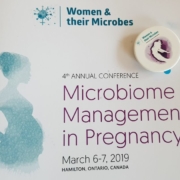“A healthy woman, a healthy baby, a healthy generation” lessons learned from the 4th Annual Women and their Microbes Conference
By Dr. Mariya Petrova, Microbiome insights and Probiotics Consultancy, Bulgaria
The 4th annual Women and their Microbes conference took place at the beginning of March celebrating the International Women’s day. The first-ever conference outside Europe in Hamilton, Canada brought together top scientists to discuss the importance of women’s health through the prism of women’s specific microbiomes. The theme of the conference was Microbiome Management in Pregnancy with a uniquely designed high-quality program translating the latest research into the clinical setting. I was honored to serve on the organizing committee for this meeting, and I provide highlights below.
Our health starts long before birth. The developing fetus receives information from the mother in the form of hormones and nutrients and uses these to predict the external environment. The fetus then uses this information to adapt its development to better its chances of survival after birth. However, the developing fetus can be “misinformed.” This happens through the maternal factors such as her use of drugs, stress, and diseases such as obesity and asthma. For example, both absolute maternal weight and weight gain during pregnancy affect microbiota development in infants (Carmen Collado et al., 2010). Maternal microbiota can also shape the immune system of the newborns. Therefore, keeping women on the right course before pregnancy and healthy during pregnancy must be a priority. This will later be translated into a healthier life for the infant through adulthood. Many of us associate healthy pregnancy with women taking the right nutrients and minerals such as folic acid, B12 vitamins, and iron and we are not wrong. But microbes also play an essential role in health. Microbes are a crucial factor providing nutrients, immune protection and regulating host physiology. Particular strains of Lactobacillus sp. and Bifidobacteria sp. can produce vitamin B12 and folic acid in the gut (Magnusdottir et al., 2015), which may be very beneficial during pregnancy. Of interest, this production increases when paired with prebiotics. Not only that, but microbes are increasingly recognized as important in reproduction, pregnancy, and development. Fertilization doesn’t happen in a sterile environment. Distinct bacterial communities are present in the female reproductive tract, but semen health and male fertility are also important (Weng et al., 2014). So don’t forget the “Y” in the equation – fathers also play a role in the health of their offspring. Gestational tissue microbes can also play an important role in development. More research is needed to better understand these microbiomes and the extent to which they can be influenced by maternal diet and health state.
What if the things go wrong – adverse pregnancy outcomes. Preterm birth is an ongoing challenge with rates steadily growing and with limited approaches for prevention. It results in 75% of neonatal morbidity and mortality. High numbers (55-80 %) of preterm births are associated with dysbiosis and a shift of the vaginal microbiota towards a more diverse state (Freitas et al., 2018). It seems likely that the vaginal microbiome can protect against adverse pregnancy outcomes. However, it appears that both antibiotics and probiotic therapy used to date are not effective at preventing preterm birth. “How to prevent adverse pregnancy outcomes?” is a million dollar question. We need a highly discriminatory diagnostic test that defines versions of ‘abnormal’ vaginal microbiomes. This test needs to be significantly associated with adverse health outcomes. The type of abnormal profile that results in preterm birth needs to be distinguishable from other possible ‘abnormal’ profiles. Such a diagnostic tool needs to be simple enough for a clinical environment and cost-effective. We need to have a safe intervention that can ‘treat’ or normalize a microbiome ideally preconception or early pregnancy.
Where do probiotics fit? Probiotics and prebiotics can enhance the nutrient status of the mother via increasing micronutrient and mineral absorption. During pregnancy, about 3.6% of North American women, 14% of The Netherlands women and 23% of Australian women consume probiotics. A lot of studies focus on the role of probiotics for preventing Group B Streptococcus infections, maternal obesities, postpartum depression, and mastitis. Although results are promising, more studies are needed to make clear conclusions and select the best strains for each condition. Importantly, currently used probiotics do not appear to pose safety concerns for pregnant and lactating women. Nevertheless, consumers’ knowledge regarding probiotics is not very precise. This confusion often may stem from a probiotic market with many different manufacturers, some of which are not legitimate, selling products that are not well defined, with very little clinical evidence. A major effort in educating clinicians, pharmacists and the consumers has been made by creating probiotic guidelines. Dragana Skokovic Sunjic has been working in the last ten years in publishing and updating the “probiotic chart.” The probiotic chart summarizes commercially available probiotic supplements or foods sold in Canada or the USA that have published clinical evidence for the particular strain(s) present in each product. Of note, for products containing multiple strains, evidence must be provided for the specified combination and not extrapolated from the evidence for the separate probiotic strains. At present these guidelines are used by primary care providers, specialists (pediatrics, GI), academic teaching hospitals, universities and others.
With the increasing number of microbiome studies, we are witnessing a paradigm shift in the scientific literature with more people focusing on the importance of microbes in human health. Women’s health is a cornerstone for successful reproduction, with important implications for the health of the next generation. Initiatives such as Women and their Microbes are crucial to link the science and medicine together to bring awareness within the healthcare and academic community.





